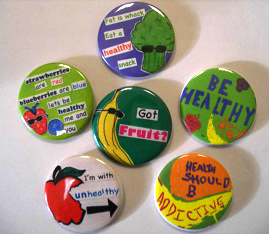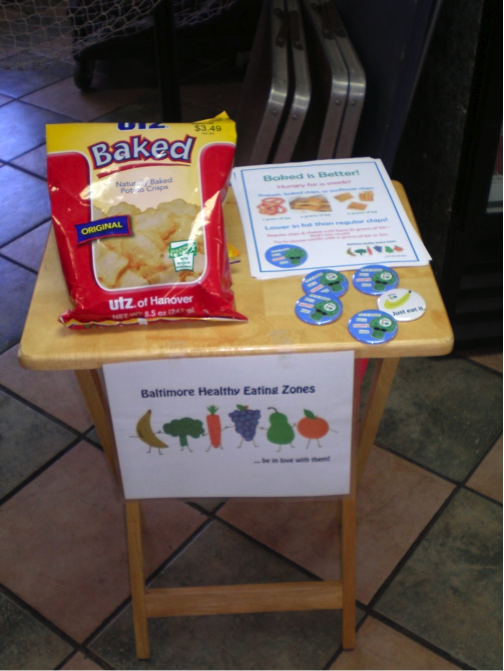Baltimore Healthy Eating Zones

Staff
Introduction/Overview
Baltimore Healthy Eating Zones (BHEZ) was a multi-level, youth-targeted obesity intervention program among African American adolescents held in recreation centers and corner stores in the Baltimore City. The project was funded by the Robert Wood Johnson Foundation and Urban Health Institute in Johns Hopkins University.
Primary Aims
Project Features
- Multi-level obesity intervention targeting youth, caregivers, and policy-makers
- 8-month intervention (Oct. 2009 – May 2010) divided by five phases; Healthy Beverages, Healthy Breakfast, Cooking at Home/ Healthy Lunch / Healthy Snacks / Carry-out
- Point-of-purchase materials in recreation centers and corner stores; shelf label, poster, flyer, giveaway, buttons.
- Interactive sessions in recreation centers and corner stores; cooking demonstration, taste test
- Education component; education of recreation center staffs, store owners, and youth study participants by peer educators and interventionists
- Connection to policy makers; cooperation with the Baltimore City Health Department
Phases of Research
|
Phase |
Name of the phase |
Promoted Behavior |
Promoted foods |
|
0 |
Teaser |
Increasing awareness of BHEZ program in local stores |
– |
|
1 |
Healthy beverage |
Choose healthier and low calorie drinks- water or diet sodas over regular sodas |
Diet sodas, 100% fruit juice, water, low-calorie drink mix (Crystal Light, Wyler’s Light) |
|
2 |
Healthy breakfast |
· Consume low-sugar, high-fiber cereals and low-fat milk.· Try fruit in cereal |
Low-sugar cereals: Cheerios, Wheat Chex, etc. High-Fiber Cereals: Wheaties, Raisin Bran, etc. Milk: 1% And Skim Milk |
|
3 |
Cooking at home/ Healthy Lunch |
· Use cooking spray when making eggs, pancakes and vegetables· Drain-and-rinse excess fat from ground beef· Buy healthier foods· Add vegetables into cooked meals· Pack a healthy lunch |
Cooking sprays, fresh/canned/frozen vegetables, fresh/canned (in light syrup/juice) fruit, 100% Whole wheat bread |
|
4 |
Healthy snacks |
· Eat fruits or vegetables for snacks· Try new ways to eat fruits and vegetables· Choose baked instead of fried snacks
|
Fresh fruits: Apple, bananas, tangerines, strawberries, raisins Vegetables: celery, carrots Low fat snacks: baked chips, pretzels, Sun Chips, yogurt, granola bars Low sugar snacks: trail mix, nuts, seeds
|
|
5 |
Carry-out |
· Choose lower-fat carry-out meals· Request less mayonnaise on foods· Choose whole wheat bread over white bread· Choose healthier sides |
Whole wheat bread, low fat and fat free mayonnaise, ketchup, mustard, healthy sides: fruits, vegetables |
Publications
Surkan PJ, Coutinho AJ, Christiansen K, Dennisuk LA, Suratkar S, Mead E, Sharma S, Gittelsohn J. (2010) “Healthy food purchasing among African American youth, associations with child gender, adult caregiver characteristics and the home food environment,” Public Health Nutrition, Oct 5:1-8. [Epub ahead of print].
http://www.ncbi.nlm.nih.gov/pubmed/20920386
Gittelsohn J, Dennisuk LA, Christiansen K, Bhimani R, Johnson A, Alexander E, Lee M, Lee SH, Rowan M, and Coutinho A. “Development and implementation of Baltimore Healthy Eating Zones: A youth-centered intervention trial to improve the food environment around recreation centers in Baltimore City” (Manuscript submitted to Public Health Nutrition, February 2011).
Coutinho AJ, Suratkar S, Dennisuk LA, Surkan PJ, Sharma S, Gittelsohn J. “Associations of youth and caregiver psychosocial factors and the home food environment with youth high-fat, high-sugar food-purchasing in low-income African American households” (Manuscript submitted to Health Education & Behavior, February 2010).
Dennisuk LA, Coutinho AJ, Suratkar S, Surkan P, Christiansen K, Riley M, Anliker JA, Sharma S, Gittelsohn J. (2011) ” Food expenditures and food purchasing among low-income urban African-American youth.” Am J Prev Med, 40(6): 625-628.
http://www.ncbi.nlm.nih.gov/pubmed/21565654
Kramer RF, Coutinho AJ, Vaeth E, Christiansen K, Suratkar S, Gittelsohn J. “Healthier home food preparation methods and youth and caregiver psychosocial factors are associated with lower BMI in African American youth,” Journal of Nutrition, (in press).
If you would like the data collection forms please email Joel Gittelsohn.




